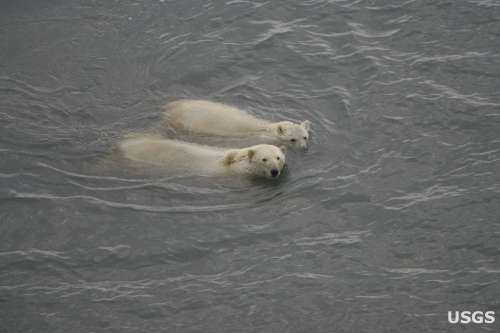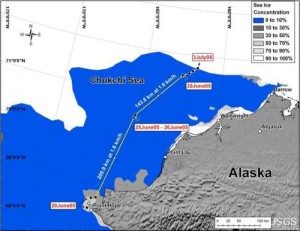
A new study shows polar bears are swimming long distances as the Arctic Ocean sea ice retreats. The United States Geological Survey documents polar bears swimming for days with little or no rest on ice floes. But the study doesn’t look at what cost these endurance swims have on the population as a whole.
Polar bears are good swimmers. They have large forelimbs that help them move through the water. But USGS researcher Anthony Pagano says it’s been impressive to document just how good they are at swimming. He used GPS data from collared polar bears to study 50 long distance swims between 2004 and 2009. The bears swam a long, long way.
“Pagano: The mean was about 95 mile long swims that these bears were taking. Annie: The mean was how long? Pagano: 95 miles. Annie: Wow, that’s incredible. Pagano: yeah. yeah.”

Pagano documented one female bear in 2008 that swam 420 miles over ten days. In that case, the swim came at a big cost.
“She had a yearling cub with her at the time the collar was deployed. And she actually started swimming a couple weeks after that and went for this long swim and then she followed the pack ice back down, over the course of the fall and she was recaptured that October and she was missing that yearling cub and she had lost I believe it was about 20 percent of her body weight,” Pagano said.
In all, 10 adult females in the study had cubs when their collars were deployed. When they were recaptured later, six still had their cubs. Pagano says researchers can’t say if it was the long swims that caused the moms and cubs to separate. And he says overall, the study couldn’t quantify how taxing the swims were for the bears.
“Their movement rates were a lot higher than they were on the sea ice, presumably because they’re not able to rest or hunt when they’re swimming. They appear to be moving continuously in the water. So presumably that might be affecting their body condition, they’re expending higher amounts of energy. But whether that’s affecting survival, we don’t know at this point,” Pogano said.
The polar bears took their long swims between July and October, when the sea ice is at its minimum. The bears can’t survive without the sea ice – they need it to hunt seals, their main food source. Biologists are trying to understand how sea ice loss is affecting the bears. And Pagano says the swimming study offers some insight into how polar bears are coping with their changing environment.
“Generally it shows that bears have an ability to move among this deteriorating sea ice habitat which historically wasn’t melting out quite as far and wasn’t in as extensive retreat as is occurring nowadays,” he said.
Pagano was speaking from Barrow, where he is finishing up the spring field season. He says they have captured about 80 bears so far this year and they appear to be in good condition. In the last few weeks of the study, the researchers are darting the bears to take small biopsy samples without having to capture them. He says the relatively new technique is less invasive and could make it easier to determine survival rates and population estimates.
Annie Feidt is the broadcast managing editor at Alaska Public Media. Reach her at afeidt@alaskapublic.org. Read more about Annie here.





